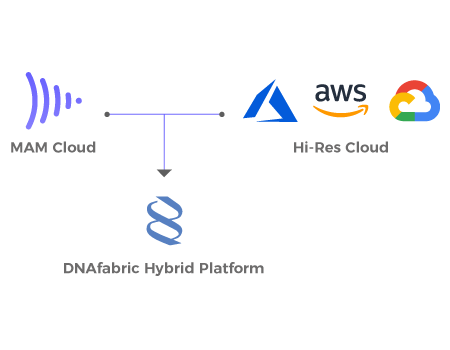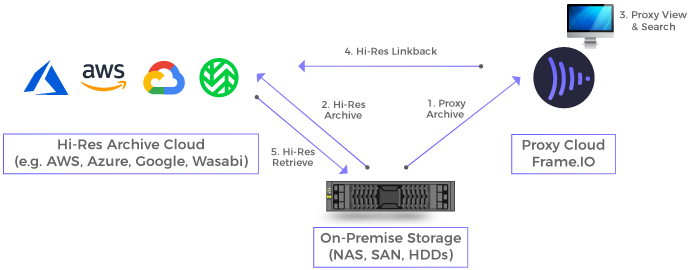
DNAfabric and Hybrid Cloud
DNAfabric combines multiple cloud providers enabling a hybrid platform for asset
management and archive. This hybrid approach delivers enterprise grade tools at a fraction
of the cost and complexity of traditional approaches.
Enterprise grade asset management & archive at dramatically lower costs

DNAfabric Hybrid Platform
DNAfabric checks in hi-res or proxy assets across different cloud providers enabling hybrid workflows for MAM and archive.
MAM Cloud
Frame.IO enables media rich proxy and metadata views for creative users.
Hi-Res Cloud
Hi-res cloud providers enable cost effective storage and access to hi-res masters.

Index On-Premise Assets with Frame.IO
DNAfabric indexes on-premise storage including NAS,SAN, HDDs, Camera Cards
while building a proxy and metadata view in Frame.IO
1. On-Premise Indexing
DNAfabric Indexers scan and index on-prem storage e.g. NAS/SAN, HDDs, camera cards.
2. Proxy Upload
DNAfabric uploads proxy files to Frame.IO in the same folder format as the on-prem storage. No hi-res assets leave the on-premise storage.
3. Proxy View & Search
Proxy assets can be searched, previewed, shared and logged directly in Frame.IO cloud.
4. Hi-Res Linkback
Proxy assets located directly in Frame.IO cloud can be linked back to the hi-res assets on-premise.

Deep Archive with AWS, Azure, Google, Wasabi Index/Proxy with Frame.IO
DNAfabric enables hi-res archiving to cloud providers specializing in long term storage (e.g. AWS, Azure, Google Wasabi)
while storing a proxy/lo-res copy in Frame.IO.
1. Proxy Archive
DNAfabric uploads a proxy version to Frame.IO. Folders, Avid/ Adobe projs, AAFs are supported for proxy archive.
2. Hi-Res Archive
Hi-res masters are uploaded to an alternate deep storage cloud provider enabling a more cost effective strategy for hi-res assets.
3. Proxy Search
Frame.IO provides a rich search and collaboration interface to the archived assets. End users can self serve and locate assets as needed.
4. Hi-Res Linkback
Located assets can be linked back to the hi-res master. DNAfabric can optionally leave behind a stub file on the on-premise storage as well.
5. Hi-Res Retrieve
Single assets or entire projects can be retrieved from deep storage cloud providers. DNAfabric automatically handles retrieves from AWS Glacier/Glacier Deep and Azure Cold Archive.
DNAfabric enables a lo-res/hi-res conform workflow utilizing Frame.IO’s proxy creation pipeline and
automated synchronization to and Frame.IO

1. Hi-Res Upload
Hi-res assets are uploaded by DNAfabric via automated sync jobs to Frame.IO.
2. Proxy Creation
Frame.IO creates multi-res proxies for all uploaded assets
3. Lo-Res Download
DNAfabric auto-downloads low-res proxies at a resolution determined by the remote users.
4. Hi-Res Conform
DNAfabric assists in the conform of the hi-res assets based on an ALE/EDL.
FAQ
Hybrid Cloud Asset Management
What is hybrid cloud asset management?
Hybrid cloud asset management utilizes a cloud-based asset management provider e.g. Frame.IO to enable indexing of on-premise assets or alternatively enables seamless exchange of assets between on-premise storage and the cloud provider. DNAfabric manages on-premise indexing and/or asset movement between on-premise and cloud.
How does hybrid cloud asset management replace traditional asset management?
Hybrid cloud asset management is a concept that breaks away from the traditional on-premise asset management strategy. On-premise asset management can be expensive and complex to setup. Rather, DNAfabric creates a seamless data flow and index of on-premise assets and a cloud MAM provider such as Frame.IO. This enables the following advantages.
What are the advantages of a hybrid cloud MAM strategy?
A hybrid cloud MAM strategy relies on cloud services with little to no initial setup or complexity to scale. Following are a few key benefits:
- Minimal to no servers or storage to setup.
- Little to no initial cost.
- No on-premise footprint to maintain.
What types of hybrid MAM workflows can be enabled?
- On-Premise Hi Res, Cloud Based Proxy
- In this workflow, DNAfabric indexes on-premise storage and hi-res assets without transferring hi-res assets to the cloud.
- First, proxies are created for the hi-res assets on-premise.
- Secondly, proxies are correlated and synced to the cloud MAM following the same directory tree and naming convention.
- Lastly, a link is created from the proxy asset to easily locate the on-premise hi-res asset.
- On-Premise Stub, Cloud Based Hi-res and Proxy
- In this workflow, the entire hi-res asset is synced to the cloud. The cloud MAM e.g. Frame.IO auto-creates proxies for the hi-res assets.
- First, the hi-res asset is synced to the cloud MAM.
- Secondly, the on-premise hi-res asset is replaced with a stub file.
- Thirdly, the cloud MAM e.g. Frame.IO creates a proxy for hi-res asset in the cloud and optionally can also archive the hi-res asset to a lower cost storage.
- Lastly, if assets need to be retrieved, they can be downloaded directly from the cloud MAM or alternatively synced down via DNAfabric.
Which file-systems can be indexed?
DNAfabric can interface with, index and incrementally watch any open file-system including camera cards, removable drives, NAS, SAN.
How do proxies get created and uploaded?
DNAfabric does not create the proxy media. To create proxies simply utilize a transcoder e.g. Adobe Media Encoder, Davinci Resolve. Once the proxies are created, utilize DNAfabric to select the source directory and proxy folder. DNAfabric correlates the proxy and hi-res, creating the same directory tree in the cloud with either hi-res or proxy content.
Hybrid Cloud Archive Management
What is hybrid cloud archive management?
Hybrid cloud archive management utilizes one or more cloud providers to enable a hybrid, best of breed archive strategy. DNAfabric utilizes a MAM cloud e.g. Frame.IO to create a searchable catalog of lo-res proxies while storing hires/masters in a more cost-effective cloud provider e.g. AWS S3 Glacier, Azure Blob Archive.
Which cloud providers can be used for lo-res/proxies?
DNAfabric uses Frame.IO to enable a browsable, searchable proxy view of the archive.
Which cloud providers can be used for the hi-res assets?
DNAfabric numerous cloud providers for storing hi-res assets. This includes the following:
- AWS S3
- Azure Blob
- Google Cloud Object
- Google Drive
- Dropbox
- OneDrive
- Box
- S3 Compatible (e.g. Minio)
How are the proxies created?
DNAfabric does not create the proxy media. To create proxies simply utilize a transcoder e.g. Adobe Media Encoder, Davinci Resolve. Once the proxies are created, utilize DNAfabric to select the source directory and proxy folder. DNAfabric correlates the proxy and hi-res, creating the same directory tree in the cloud for hi-res (in the archive cloud) or proxy (in the MAM cloud).
How is the lo-res proxy associated with the hi-res asset and how are retrieves performed?
DNAfabric stores a web url with every asset in Frame.IO. This allows users to link back to the original asset and initiate a retrieve.
How do proxies get created and uploaded?
DNAfabric does not create the proxy media. To create proxies simply utilize a transcoder e.g. Adobe Media Encoder, Davinci Resolve. Once the proxies are created, utilize DNAfabric to select the source directory and proxy folder. DNAfabric correlates the proxy and hi-res, creating the same directory tree in the cloud with either hi-res or proxy content.













